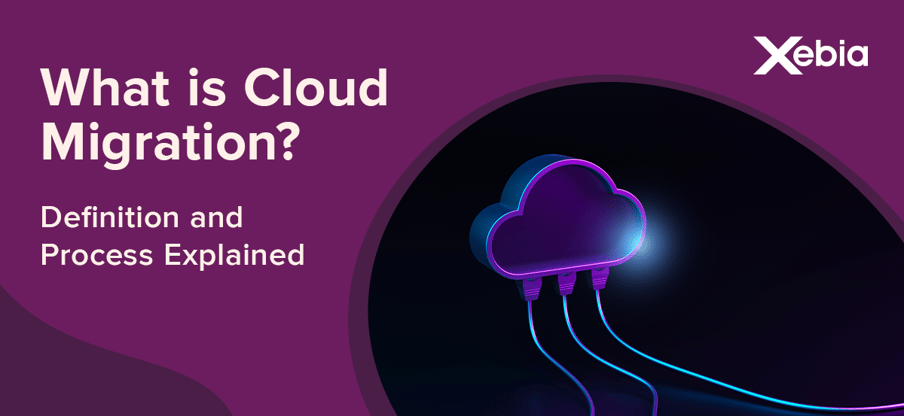In 2022, more and more organizations decide to move to the Cloud. Experts predict that already this year, 67% of all enterprise infrastructure will be Cloud-based. What’s more, 81% of all enterprises reported having a multi-cloud strategy in the works.
If you’re also considering moving to the Cloud – or are just wondering what the buzz is all about – you’re in the right place. In this article, we’ll tell you more about what Cloud Migrations is and what the process looks like (or, rather, what it should look like).

Table of Content:
- What Does Moving to the Cloud Mean - What is Cloud Migration?
- Benefits of Cloud Migration
- What are the Challenges with Cloud Migration?
- The Cloud Migration Process
- What is Cloud Migration Strategy and How to Prepare it
- Consider Migrating to The Cloud Today
What Does Moving to the Cloud Mean - What is Cloud Migration?
But first – what is Cloud Migration, exactly?
Shortly speaking, Cloud Migration is the process of moving applications, databases, and IT processes to the Cloud. It typically means moving data and tools from legacy infrastructure or an on-premises data centre to the Cloud.
On a sidenote – Cloud Migration can also mean moving from one Cloud to another. However, in this article, we won’t focus on that perspective.
If, at this point, you’re thinking – Hey, but what are all these Clouds you just mentioned? Are you talking about the cumulonimbi on the horizon? – then don’t worry. Just read the first article from this series and everything will be clear as the sky is blue (when there are no clouds, obviously)
Benefits of Cloud Migration
The Cloud is popular for a reason. A Cloud Migration can have an enormously positive impact on an organization. If planned well and done right, it delivers strong, long-lasting benefits, like:
- boosted agility and flexibility,
- better performance,
- the ability to innovate faster,
- easing of increasing resource demands,
- the ability to better manage increased customer expectations,
- cost reduction,
- better consumption management,
- and scalability.
The precise benefits depend on various factors – like an organization’s way of operating, the business model, or the industry it operates in. But, overall, the perks usually include a reduced cost of ownership (TCO), a swifter time to delivery, or higher flexibility. What’s more, Cloud Migration typically serves as a driveway to further innovation (and that way leads to even more benefits).
So, in a nutshell, Cloud Computing can empower your infrastructure to support larger workloads and more users, enable you to spend less on IT operations, help you to improve end-user experience through better performance, and contribute to overall higher user satisfaction.
What are the Challenges with Cloud Migration?
If you’re now all excited about the abovementioned business miracles, hold your horses for just a second. We need to talk about the difficult part first.
Since so many organizations keep moving to the Cloud, Cloud Migration may sound like a trivial day-to-day activity. However, migrating to the Cloud can still be a complex affair – difficult and risky. To make the transition relatively problem-free, before you move anything to the Cloud, you first need to strike an important item from the to-do list: planning.
Strategy
The first thing you’ll need is a good strategy.
Many enterprises begin their migration without it. And without a proper Cloud migration strategy, it’s nearly impossible to enjoy a successful Cloud infrastructure.
Rigorous end-to-end planning is required. Each of a company’s application and dataset may have other Cloud requirements and need different considerations. Most of all, you should be able to present a clear business case for each migrated workload. If a workload doesn’t seem to have one, it won’t make sense to move that element to the Cloud. After all, no benefits will come from it anyway.
KPIs
Next, an organization should define precise KPIs. With these indicators, an enterprise will be able to clearly understand how much the Cloud infrastructure will cost after migration.
Additionally, it will also help to gain an idea of how much money the migration will save in comparison to pre-migration. Without such an estimation, you may not only throw money away on a complex operation that won’t bring anything – but it even will be hard to assess the effects when moving to the Cloud proves optically successful. It’s important to stress that such estimations should be done diligently. Cloud environments are dynamic, and their costs can change as you adopt new services are the usage of your apps grows.
Security
Finally, you should also consider compliance and data security. The key point here is – do it early on. Having a good Cloud Security Architecture helps. Because although the Cloud, at its core, is a safe technology – problems do happen. Let us give you some context.
Big platform leaders like Amazon Web Services (AWS), Google Cloud Platform (GCP), or Microsoft Azure make great efforts to stay secure and meet various levels of certification. As a result, the problem rarely lies in the technology itself – but in the components and solutions built within. In 2019, around 90% of all Cloud-based security issues resulted not from Cloud faults themselves, but from misconfiguration. Having a proficient strategy for your Cloud Security Architecture minimizes this risk.
The Cloud Migration Process
As you can imagine by now, migrating to the Cloud doesn’t happen overnight. As we’ve mentioned, it needs to be planned properly.
Usually, a Cloud Migration Process involves at least 4 steps.
As a start, you need to ask yourself a question – why do you want to move to the Cloud?
It’s not a good enough answer that your colleague Eric from ThePerfectRetailWorld.eu is doing it. Your organization’s decision-makers need to be clear on the purpose of the migration. This includes creating a baseline of your current IT infrastructure and defining Cloud Migration KPIs to measure your Cloud migration success.
Next, you need to plan the practical side.
Decide what to migrate first and how. Evaluate which applications can be moved as they are, and which will need rework. Analyze which available tools will help you with migrating the more complex workloads. Choose which Cloud deployment model to go with. Assess the possible ROI and how long it will take you to achieve it.
After the planning stage, it’s time for the nitty-gritty – actually migrating. Obviously, it’s recommended not to go with business-critical elements first.
Finally, after all that is done, you can turn off the legacy systems you moved to the Cloud. And this step is not necessarily the end of the journey. Migrating to the Cloud can be an ongoing process.
What is Cloud Migration Strategy and How to Prepare it
We’ve mentioned how important the Cloud Migration Strategy is. Let’s talk about it some more.
A Cloud Migration Strategy is a high-level plan that outlines how to move existing on-premises and/or co-located application workloads and their associated data into the Cloud.
A good Cloud Migration strategy will need to include a prioritization of workloads for migration, determining the migration plan for individual workloads, developing a pilot, testing, and adjusting the strategy based on the pilot results.
When developing your strategy – regardless of your decisions regarding specific migration types (which we’re discussing in detail below) – you should ideally rely on the following logic:
- What you’re moving.
- Why you’re moving it.
- How you’re going to do it.
Now, when it comes to the specific migration types you’ll need to include in your general strategy, the main three approaches of Cloud migration to consider are:
Lift and shift (rehosting)
Move and improve (replatforming)
Rip and replace (refactoring)
Additionally, there are also other migration types, like repurchasing, relocating, retaining, and retiring.
What is Refactoring in Cloud Migration?
Also known as rip and replace, the goal of refactoring is to restructure and optimize the existing code to remove technical debt and improve nonfunctional attributes. Importantly, re-coding an existing application enables you to enjoy the full range of Cloud-native features. The latter part is refactoring’s crucial advantage. Many other migration types will only offer a limited array of Cloud-related benefits.
Leaning toward refactoring means taking your time. Specifically, it includes diligent planning and preparation – for example, ensuring that your team members possess the skill set to move and refactor the code.
Repurchase as Migration Strategy
Re-purchasing means moving to a different product – usually a SaaS platform – and dropping your own on-premise solution. For example, this could mean moving your CRM to Salesforce.com or your HR system to Workday.
It’s quick and convenient. However, since some solutions can be hard to replace due to their unique business value (legacy systems in particular), repurchasing isn’t always a viable choice.
What is Rehosting?
Also called the lift and shift strategy, re-hosting means moving your solution from on-premise hosting to the Cloud. It’s viewed as quick and easy since it doesn’t require any architecture changes or coding. Unfortunately, it also doesn’t offer full Cloud infrastructure benefits. As a result, it’s not always very effective.
Usually, rehosting is used for simple, low-impact workloads – particularly by organizations that aren’t very Cloud mature.
Relocation in Cloud Migration
Relocation, also known as hypervisor-level lift and shift, means moving your infrastructure to the Cloud without rewriting applications, acquiring new hardware, or modifying your existing operations. This scenario is specific to VMware Cloud on AWS, which support virtual machine (VM) compatibility and workload portability between on-premises and AWS.
What do You Need to Know About Replatforming?
Also described as rehosting with optimization or move and improve, replatforming is similar to re-hosting, but additionally aims to adjust your solutions and assets to be ready to deliver more Cloud benefits.
However, re-platforming isn’t about changing the core architecture of the application. It mainly concentrates on adding modern updates to the application. Replatforming can be seen as a middle way between rehosting and refactoring, but it can also become a trap. It’s not uncommon for a move and improve migration to end up carrying over all the technical debt and delivering absolutely no Cloud-native benefits in the process.
Retaining as a Migration Strategy
The last strategy is the easiest to execute but may become the most difficult to accept. Its goal is to do… nothing.
Sometimes your organization may not be ready to migrate. You should only migrate if it makes sense from the business perspective. And if, for example, your application has been upgraded very recently, it may not be sensible to move to the Cloud right away. That’s why retaining is also called “revisiting”. After all, Cloud migration should be your end game – but just not right here and right now.
Finally, after retaining, there’s also retiring – which means decommissioning or removing applications that are no longer needed in your source environment. So, if you can throw something away without any consequences to your operation – great! One less thing to worry about.
Consider Migrating to The Cloud Today
A few years back, the Cloud has been considered an advantage – some sort of bonus asset. However, in 2022, it’s hardly the case.
So, don’t fall behind. Start by preparing an inventory of your IT portfolio and analyze which applications and systems would deliver the most benefits if migrated.





